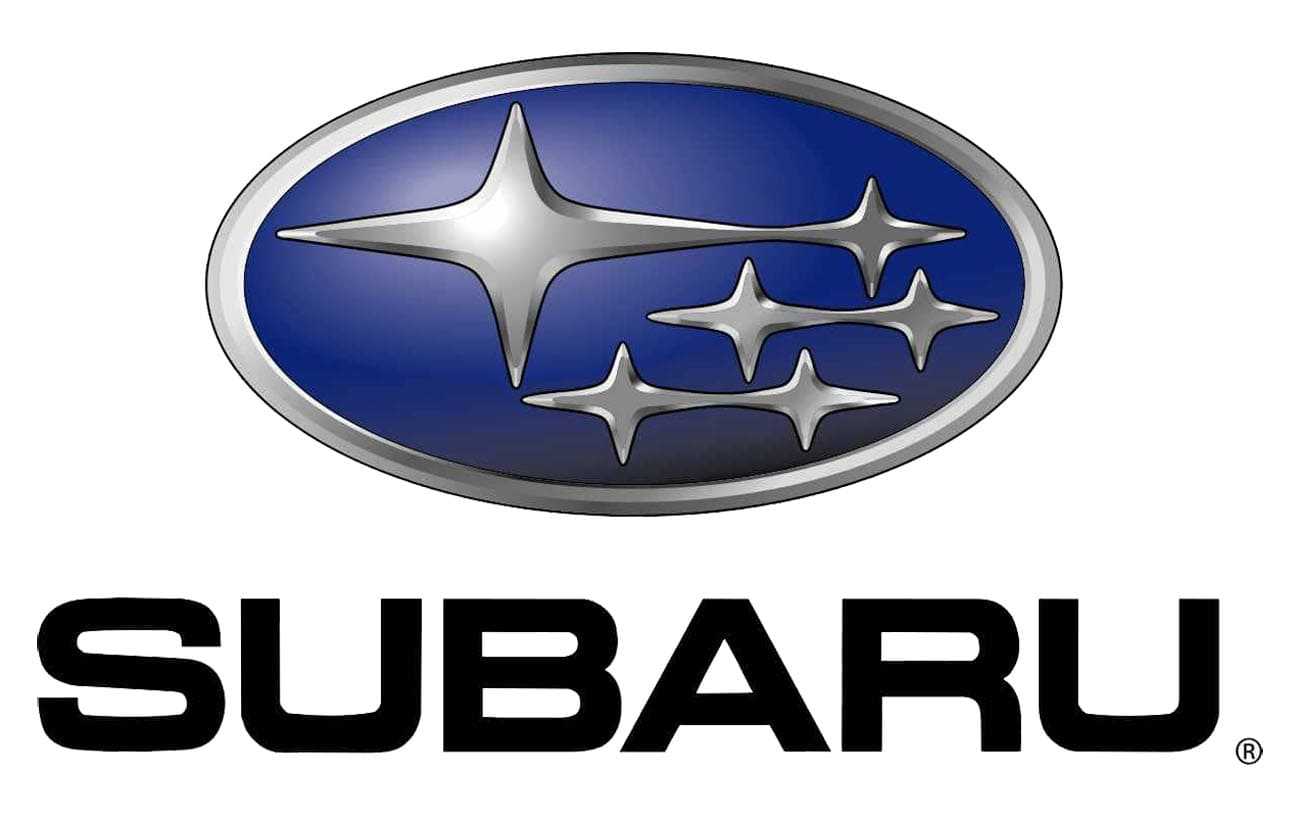
2025 Subaru BRZ Tires and Wheels User Guide
Sporty, lightweight alloy wheels for improved handling and performance are a highlight of the 2025 Subaru BRZ. With their superior grip, stability, and sensitive steering, high-performance tires ideally match the BRZ’s nimble, rear-wheel-drive sports car attributes.
2023 – 2024 Subaru BRZ Review, Specs, Price and Mileage (Brochure)
Subaru Tires and Wheels Guide
Types of Tires
You should be familiar with type of tire s present on your vehicle.
Summer tires
The factory-installed tires on your ne w vehicle are summer tires.
Summer tires are high-speed capabilit y tires best suited for highway driving unde r dry conditions.
Summer tires are inadequate for drivin g on slippery roads such as on snow-covered or icy roads.
If you drive your vehicle on snow-covere d or icy roads, we strongly recommend th e use of winter (snow) tires.
When installing winter tires, be sure t o replace all four tires.
All season tires
All season tires are designed to provid e an adequate measure of traction, handlin g and braking performance in year-roun d driving including snowy and icy roa d conditions. However all season tires d o not offer as much traction performance a s winter (snow) tires in heavy or loose sno w or on icy roads.
All season tires are identified by AL L SEASON and/or M+S (Mud & Snow) on the tire sidewall.
Winter (snow) tires
Winter tires are best suited for driving o n snow-covered and icy roads. Howeve r winter tires do not perform as well a s summer tires and all season tires on road s other than snow-covered and icy roads.
NOTE
If the tread wears down below 0.16 in. (4mm) on snow tires the effectivenes s of snow tires is lost.
Low profile tires
Generally, low profile tires will wear mor e rapidly and tire grip performance will b e reduced on snowy and/or icy roads whe n compared to standard tires. Be sure t o use snow tires or tire chains on snow y and/or icy roads and drive carefully at a speed appropriate for road and weathe r conditions.
NOTE
Low profile tires may cause greate r damage than usual to the wheel whe n receiving impact from the road sur-face. Therefore pay attention to the fol-lowing:
- Be sure to use proper tire inflatio n pressure. If tires are under-inflated , they may be damaged more severely.
- Avoid pot holes, uneven pavement, curbs and other road hazards. Failur e to do so may lead to severe tire an d wheel damage.
Tire Pressure Monitoring System (TPMS) (If Equipped)
The tire pressure monitoring syste m provides the driver with a warnin g message by sending a signal from a sensor that is installed in each wheel when tire pressure is severely low. Th e tire pressure monitoring system will acti-vate only when the vehicle is driven. Also, this system may not react immediately t o a sudden drop in tire pressure (fo r example, a blow-out caused by runnin g over a sharp object).
If you adjust the tire pressures in a war m garage and will then drive the vehicle i n cold outside air, the resulting drop in tir e pressures may cause the low tire pressur e warning light to illuminate. To avoid thi s problem when adjusting the tire pressure s in a warm garage, inflate the tires to pres-sures higher than those shown on the tir e inflation pressure label. Specifically, inflate them by an extra 1 psi (6.9 kPa,
0.07 kgf/cm2) for every difference of 10° F (5.6°C) between the temperature in th e garage and the temperature outside. B y way of example, the following table show s the required tire pressures that corre-spond to various outside temperature s when the temperature in the garage i s 60°F (15.6°C).
Example:
Tire size: 215/40R18 85Y
Standard tire pressures:
Front: 35 psi (240 kPa, 2.4 kgf/cm2)
Rear: 35 psi (240 kPa, 2.4 kgf/cm2)
Garage temperature: 60°F (15.6°C)
| Outside temperature | Adjusted pressure [psi (kPa, kgf/cm2)] | |
| Front | Rear | |
| 30°F (−1°C) | 38 (260, 2.6) | 38 (260, 2.6) |
| 10°F (−12°C) | 40 (275, 2.75) | 40 (275, 2.75) |
| −10°F (−23°C) | 42 (290, 2.9) | 42 (290, 2.9) |
Example:
Tire size: 215/45R17 87W Standard tire pressures:
Front: 35 psi (240 kPa, 2.4 kgf/cm2)
Rear: 35 psi (240 kPa, 2.4 kgf/cm2) Garage temperature: 60°F (15.6°C)
| Outside temperature | Adjusted pressure [psi (kPa, kgf/cm2)] | |
| Front | Rear | |
| 30°F (−1°C) | 38 (260, 2.6) | 38 (260, 2.6) |
| 10°F (−12°C) | 40 (275, 2.75) | 40 (275, 2.75) |
| −10°F (−23°C) | 42 (290, 2.9) | 42 (290, 2.9) |
If the low tire pressure warning light illumi-nates when you drive the vehicle in col d outside air after adjusting the tire pres-sures in a warm garage, re-adjust the tir e pressures using the method describe d above. Then, increase the vehicle spee d to at least 25mph (40km/h) and check t o see that the low tire pressure warning light goes off a few minutes later. If the low tir e pressure warning light does not go off, th e tire pressure monitoring system may no t be functioning normally. In this event, g o to a SUBARU dealer to have the system inspected as soon as possible.
While the vehicle is driven, frictio n between tires and the road surfac e causes the tires to warm up. After illumi-nation of the low tire pressure warnin g light, any increase in the tire pressure s caused by an increase in the outside ai r temperature or by an increase in th e temperature in the tires can cause the lo w tire pressure warning light to go off.
System resetting is necessary when th e wheels are changed (for example, a switch to snow tires) and new TPM S valves are installed on the newly fitte d wheels. Have this work performed by a SUBARU dealer following wheel replace-ment.
It may not be possible to install TPM S valves on certain wheels that are on th e market. Therefore, if you change th e wheels (for example, a switch to sno w tires), use wheels that have the same part number as the standard-equipment wheels. Without four operational TPM S valve/sensors on the wheels, the TPM S will not fully function and the warning light in the instrument panel will illuminat e steadily after blinking for approximatel y one minute.
When a tire is replaced, adjustments ar e necessary to ensure continued normal operation of the tire pressure monitorin g system. As with wheel replacement, therefore, you should have the wor k performed by a SUBARU dealer.
WARNING
If the low tire pressure warning ligh t does not illuminate briefly after th e ignition switch is turned ON or th e light illuminates steadily after blink-ing for approximately one minute , you should have your Tire Pressur e Monitoring System checked at a SUBARU dealer as soon as possi-ble.
If this light illuminates while driving , never brake suddenly. Instead, per-form the following procedure. Oth-erwise an accident involvin g serious vehicle damage and seriou s personal injury could occur.
- Keep driving straight ahead whil e gradually reducing speed.
- Slowly pull off the road to a saf e place.
If this light still illuminates whil e driving after adjusting the tire pres-sure, a tire may have significan t damage and a fast leak that cause s the tire to lose air rapidly. If yo u have a flat tire, refer to “Flat Tires “.
When a spare tire is mounted or a wheel rim is replaced without th e original pressure sensor/transmitte r being transferred, the low tire pres-sure warning light will illuminat e steadily after blinking for approxi-mately one minute. This indicate s the TPMS is unable to monitor al l four road wheels. Contact you r SUBARU dealer as soon as possi-ble for tire and sensor replacemen t and/or system resetting. If the ligh t illuminates steadily after blinkin g for approximately one minute, promptly contact a SUBARU deale r to have the system inspected.
Tire Inspection
Check on a daily basis that the tire s are free from serious damage, nails, and stones. At the same time, chec k the tires for abnormal wear. Contact your SUBARU deale r immediately if you find any problem.
NOTE
- When the wheels and tire s strike curbs or are subjected t o harsh treatment as when th e vehicle is driven on a roug h surface, they can suffer damag e that cannot be seen with th e naked eye. This type of damag e does not become evident unti l time has passed. Try not to driv e over curbs, potholes or on othe r rough surfaces. If doing so i s unavoidable, keep the vehicle s speed down to a walking pace o r less, and approach the curbs a s squarely as possible. Also, mak e sure the tires are not presse d against the curb when you par k the vehicle.
- If you feel unusual vibratio n while driving or find it difficult t o steer the vehicle in a straight line, one of the tires and/or wheels may be damaged. Drive slowly t o the nearest authorized SUBAR U dealer and have the vehicl e inspected.
- Tires should be replaced if:
- You have tire damage suc h as cuts, splits, cracks dee p enough to expose the fabric o r bulges indicating interna l damage
- A tire goes flat repeatedly o r cannot be properly repaire d due to the size or location of a cut or other damage
If you are not sure, consult wit h your SUBARU dealer.
- Any tires over 6 years old mus t be checked by a qualified techni-cian even if they have seldom o r never been used or damage i s not obvious.
Tire Pressures and Wear
Maintaining the correct tire pres-sures helps to maximize the tires service lives and is essential fo r good running performance. Chec k and, if necessary, adjust the pres-sure of each tire and the spare (if equipped) at least once a mont h and before any long journey.
Tire inflation pressure label
Check the tire pressures when th e tires are cold. Use a pressure gaug e to adjust the tire pressures to th e values shown on the tire inflatio n pressure label. The tire inflatio n pressure label is located on th e center pillar on the drivers side.
Driving even a short distanc e warms up the tires and increase s the tire pressures. Also, the tir e pressures are affected by th e outside temperature. It is best t o check tire pressure outdoors befor e driving the vehicle.
When a tire becomes warm, the ai r inside it expands, causing the tir e pressure to increase. Be careful not to mistakenly release air from a warm tire to reduce its pressure.
NOTE
- The air pressure in a tir e increases by approximately 4. 3 psi (30 kPa, 0.3 kgf/cm2) when th e tire becomes warm.
- The tires are considered col d when the vehicle has bee n parked for at least 3 hours or ha s been driven less than 1 mile (1. 6 km).
WARNING
Do not let air out of warm tire s to adjust pressure. Doing s o will result in low tire pressure.
Incorrect tire pressures detract fro m controllability and ride comfort, an d they cause the tires to wear abnor-mally.
- Correctly inflated tires (trea d worn evenly)
 Roadholding is good, and steerin g is responsive. Rolling resistance i s low, so fuel consumption is als o lower.
Roadholding is good, and steerin g is responsive. Rolling resistance i s low, so fuel consumption is als o lower.
- Under inflated tires (tread worn a t shoulders)
 Rolling resistance is high, so fuel consumption is also higher.
Rolling resistance is high, so fuel consumption is also higher.
- Over inflated tires (tread worn i n center)
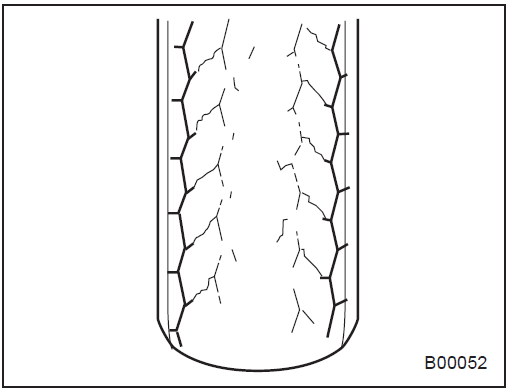 Ride comfort is poor. Also, the tir e magnifies the effects of roa d surface bumps and dips, possibl y resulting in vehicle damage.
Ride comfort is poor. Also, the tir e magnifies the effects of roa d surface bumps and dips, possibl y resulting in vehicle damage.
WARNING
Driving at high speeds wit h excessively low tire pressure s can cause the tires to defor m severely and to rapidl y become hot. A sharp increas e in temperature could caus e tread separation, and destruc-tion of the tires. The resultin g loss of vehicle control coul d lead to an accident.
Wheel Balance
Each wheel was correctly balance d when your vehicle was new, but th e wheels will become unbalanced a s the tires become worn during use. Wheel imbalance causes th e steering wheel to vibrate slightly at certain vehicle speeds and detract s from the vehicles straight-lin e stability. It can also cause steerin g and suspension system problem s and abnormal tire wear. If yo u suspect that the wheels are not correctly balanced, have the m checked and adjusted by you r SUBARU dealer. Also have the m adjusted after tire repairs and afte r tire rotation.
CAUTION
Loss of correct wheel align-ment causes the tires to wea r on one side and reduces th e vehicles running stability . Contact your SUBARU deale r if you notice abnormal tir e wear.
NOTE
The suspension system i s designed to hold each wheel at a certain alignment (relative to th e other wheels and to the road) fo r optimum straight-line stabilit y and cornering performance.
Wear Indicators
- New tread
- Worn tread
- Tread wear indicator
Each tire incorporates a tread wea r indicator, which becomes visibl e when the depth of the tread groove s decreases to 0.063 in (1.6 mm). A tire must be replaced when th e tread wear indicator appears as a solid band across the tread.
WARNING
When a tires tread wear indi-cator becomes visible, the tir e is worn beyond the accept-able limit and must b e replaced immediately. With a tire in this condition, driving a t high speeds in wet weathe r can cause the vehicle t o hydroplane. The resulting los s of vehicle control can lead t o an accident.
NOTE
For safety, inspect the tire trea d regularly and replace the tire s before their tread wear indicator s become visible.
Rotational Direction of Tires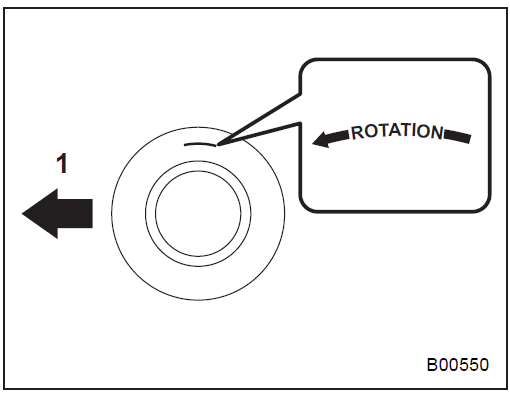
Example of rotational directio n marked on the sidewall
- Front
If the tires have specific rotational direction, refer to the arrow marke d on the side wall.
The arrow should be pointin g forward direction when the wheel s are fitted.
Tire Rotation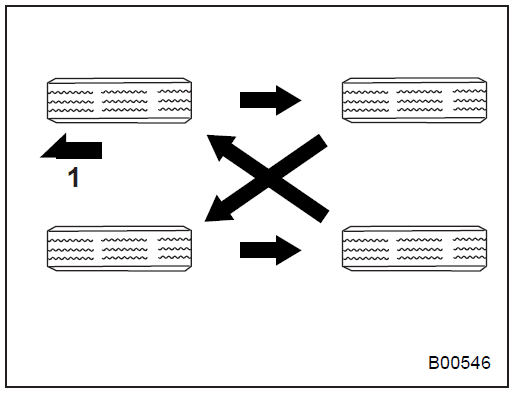
Vehicles equipped with 4 nonunidirectional tires
- Front
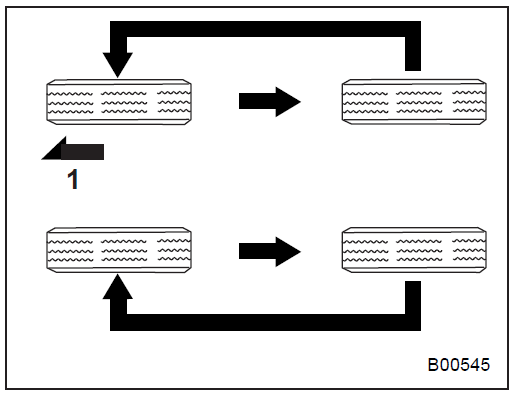 Vehicles equipped with unidi-rectional tires
Vehicles equipped with unidi-rectional tires
- Front
Tire wear varies from wheel t o wheel. Move the tires to the posi-tions shown in the illustration eac h time they are rotated. For the tir e rotation schedule, refer to th e Warranty and Maintenanc e Booklet
Replace any damaged or unevenl y worn tire at the time of rotation. After tire rotation, adjust the tire pres-sures and make sure the wheel nut s are correctly tightened. After driving approximately 60 0 miles (1,000 km), check the wheel nuts again and retighten any nut that has become loose.
Tire Replacement
The wheels and tires are important an d integral parts of your vehicles design; they cannot be changed arbitrarily. Th e tires fitted as standard equipment are opti-mally matched to the characteristics of th e vehicle and were selected to give the best possible combination of running perfor-mance, ride comfort, and service life. It i s essential for every tire to have a size an d construction matching those shown on th e tire inflation pressure label and to have a speed symbol and load index matchin g those shown on the tire inflation pressur e label.
Using tires of a non-specified size detract s from controllability, ride comfort, brakin g performance, speedometer accuracy an d odometer accuracy. It also creates incor-rect body-to-tire clearances and inappro-priately changes the vehicles groun d clearance.
All four tires must be the same in terms of manufacturer, brand (tread pattern), construction, and size. You are advised t o replace the tires with new ones that ar e identical to those fitted as standard equip-ment.
For safe vehicle operation, SUBAR U recommends replacing all four tires at th e same time.
WARNING
- When replacing or installin g tire(s), all four tires must be th e same for the following items.
- Size
- Speed symbol
- Load index
- Circumference
- Construction
- Manufacturer
- Brand (tread pattern)
- Degrees of wear
For items (a) to (c), you mus t obey the specification that i s printed on the tire inflation pres-sure label. The tire inflation pres-sure label is located on th e drivers center pillar.
If all four tires are not the same i n items (a) to (h), serious mechani-cal damage could be caused t o the drivetrain of the car, an d affect the followings. - Ride
- Handling
- Braking
- Speedometer/Odometer cali-bration
- Clearance between the bod y and the tires
It also may be dangerous an d lead to loss of vehicle control , and it can lead to an accident.
- Use only radial tires. Do not us e radial tires together with belte d bias tires and/or bias-ply tires . Doing so can dangerously reduc e controllability, resulting in a n accident.
2023 – 2024 Subaru BRZ Review, Specs, Price and Mileage (Brochure)
Replacement procedure
WARNING
- Use only the jack and the jack handle provided with you r vehicle. The jack supplied with the vehicle is designed only for changing a tire. Never put any part of your body under the vehicle while the vehicle is being supported by the jack. Doing so could result in serious injury or death.
- Do not jack up the vehicle on an incline or a loose road surface. The jack can come out of the jacking point or sink into the ground and this can result i n serious injury or death.
- Before jacking up the vehicle, be sure that there are no occupant s or cargo on board.
- Do not jack up the vehicle with an object on or underneath the jack . The jack can be unstable and this can result in a severe accident.
- Always turn off the engine before raising the tire off the ground using the jack. Never swing o r push the vehicle supported with the jack. The jack can come out of the jacking point due to a jolt and this can result in serious injury or death.
- All passengers must exit th e vehicle before you raise it with the jack. Raising the vehicle with someone inside of it could result in serious injury or death.
- Do not start the vehicle while it is supported by the jack. Doing so could result in serious injury or death.
CAUTION
Do not hit and bend the disc roto r backing plate when removing and installing the tire. A bent backing plate may scrape against the dis c rotor and cause noise while th e vehicle is in motion.
NOTE
Contact a SUBARU dealer when jack-ing up the vehicle using a garage jack.
- Park on a hard, level surface, when-ever possible, then stop the engine.
- Set the parking brake securely and shift the shift lever in reverse (MT models) or the select lever to the “P” (Park) posi-tion (AT models).
- Turn on the hazard warning flashe r and unload all occupants and luggage from the vehicle.

- Put wheel blocks at the front and rear of the tire diagonally opposite the flat tire.
- Take out the jack, jack handle and wheel nut wrench.
NOTE
Make sure that the jack is well lubri-cated before using it.
- Loosen the wheel nuts using the wheel nut wrench but do not remove the nuts.

- Place the jack under the side sill at the front or rear jack-up point closest to the tire to be replaced.

Turn the jackscrew by hand until the jack head engages firmly into the jack-up point.
- Insert the jack handle into the jack-screw, and turn the handle until the tire clears the ground. Do not raise the vehicl e higher than necessary.
- Remove the wheel nuts and the tire to be replaced.


- Before putting the new tire on, clea n the mounting surface of the wheel an d hub with a cloth.
- Put on the new tire. Replace the wheel nuts. Tighten them by hand.
WARNING
Do not use oil or grease on the wheel studs or nuts when the ne w tire is installed. This could caus e the nuts to become loose and lead to an accident. - Turn the jack handle counterclockwise to lower the vehicle.

- Use the wheel nut wrench to securely tighten the wheel nuts to the specified torque, following the tightening order in the illustration.
For the wheel nut tightening torque, refer to “Tires”. Never use your foot on the wheel nut wrench or a pipe extensio n on the wrench because you may exceed the specified torque. Have the wheel nut torque checked at the nearest automotive service facility. - Store the jack, jack handle and wheel nut wrench in their storage locations.
WARNING
Never place the tire to be replaced or tire changing tools in the passen-ger compartment after changing a new tire. In a sudden stop or colli-sions, loose equipment could strike occupants and cause injury. Stor e the all tools in the proper place.
Alloy Wheels
Alloy wheels can be scratched an d damaged easily. Handle them carefully t o maintain their appearance, performance, and safety.
- When any of the wheels is remove d and replaced for tire rotation or to chang e a flat, always check the tightness of th e wheel nuts after driving approximately 60 0 miles (1,000 km). If any nut is loose, tighten it to the specified torque.
- Never apply oil to the threaded parts, wheel nuts, or tapered surface of th e wheel.
- Never let the wheel rub against shar p protrusions or curbs.
- When wheel nuts, balance weights, o r the center cap is replaced, be sure t o replace them with genuine SUBARU part s designed for alloy wheels.
Useful Links:
2023 – 2024 Subaru BRZ Review, Specs, Price and Mileage (Brochure)

